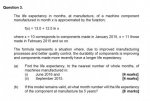Question 3: The life expectancy in months, at manufacture, of a machine component manufactured in month x is approximated by the following function:
. . . . .\(\displaystyle f(x)\, =\, 13.0 + 12.5\, \ln(x)\)
...where "x = 10" corresponds to components made in January 2015, "x = 11" to those made in February 2015, and so on.
The formula represents a situation where, due to improved manufacturing processes and better quality control, the durability of components is improving and components made more recently have a longer life expectancy.
(a) Find the life expectancy, to the nearest number of whole months, of machines manufactured in:
. .(i) June 2016, and
. .(ii) September 2015
(b) If this model remains valid, at what whole-month number will the life expectancy of the component be 5 years?
How do i do this?
Thanks
. . . . .\(\displaystyle f(x)\, =\, 13.0 + 12.5\, \ln(x)\)
...where "x = 10" corresponds to components made in January 2015, "x = 11" to those made in February 2015, and so on.
The formula represents a situation where, due to improved manufacturing processes and better quality control, the durability of components is improving and components made more recently have a longer life expectancy.
(a) Find the life expectancy, to the nearest number of whole months, of machines manufactured in:
. .(i) June 2016, and
. .(ii) September 2015
(b) If this model remains valid, at what whole-month number will the life expectancy of the component be 5 years?
How do i do this?
Thanks
Attachments
Last edited by a moderator:

